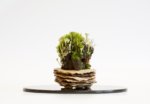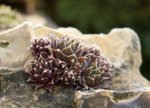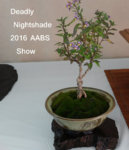You are using an out of date browser. It may not display this or other websites correctly.
You should upgrade or use an alternative browser.
You should upgrade or use an alternative browser.
The Accent (Companion) Plant Thread
- Thread starter zachkent29
- Start date
atlarsenal
Omono
wsteinhoff
Shohin
Leo in N E Illinois
The Professor
- Messages
- 11,595
- Reaction score
- 24,228
- USDA Zone
- 5b
Here is my Habenaria radiata, aka Pecteilis radiata - egret orchid from 2016. It did not survive the 2016-2017 winter, much to my same. It was potted in a lovely Bunzan pot, beautiful blue glaze with yellow highlights.
How to grow and things to do different next time.
Potting mix, mine worked well enough. blend of fine fir bark for seedling orchids, Kanuma, perlite, chopped long fiber sphagnum, a small portion of fine sand (play sand) top dress with a layer of sphagnum moss, then plant living ''crack in the sidewalk moss''. They want a mildly acidic, water retentive mix that breathes well, allowing good air penetration.
Water - these never want to dry out completely - in nature they come from edges of bogs and swampy areas. Usually in grassy hummocks, where the bulb is above the water but roots can head down to get into water. They are somewhat sensitive to excess Calcium, use rainwater as much as possible. If you use tap water, try to follow up with rain water the next day. If you use liquid fertilizer, use the one for acid loving trees and shrubs. Organic fertilizers should be no problem. Keep fertilizer solution dilute, one half or one quarter strength.
Sun, should have 3 to 8 hours of direct sun daily. Morning sun is best.
Leave outdoors until light frost. Then either unpot bulbs, pack in damp moss and refrigerate for winter in a plastic bag or put whole pot in the refrigerator. Replant, repot or set outside after danger of frost has past in spring. Hardy through zone 8, possibly into zone 7.
Things to do different. - most important. This orchid is thin and grassy, needs support when blooming. In order to get flower stems to stand up straight without unnatural props, stakes, bamboo skewers or whatever, you should plant a thin, not too aggressive sedge or grass in the pot with the orchid. The blades of grass will provide support for the orchid flower stems. The grass roots will help move water (requiring more water) which will keep the mix fresher. The grass will shade the leaves of the orchid a little, allowing to give the orchid more direct sun. They really do want sun. A larger pot with a mix of ferns and grasses would result in hardier growth of the orchid. Adding grasses or sedges also makes the planting a true kusamono. Kusamono means grass planting.

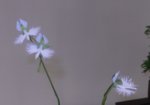
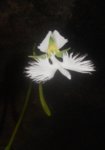
How to grow and things to do different next time.
Potting mix, mine worked well enough. blend of fine fir bark for seedling orchids, Kanuma, perlite, chopped long fiber sphagnum, a small portion of fine sand (play sand) top dress with a layer of sphagnum moss, then plant living ''crack in the sidewalk moss''. They want a mildly acidic, water retentive mix that breathes well, allowing good air penetration.
Water - these never want to dry out completely - in nature they come from edges of bogs and swampy areas. Usually in grassy hummocks, where the bulb is above the water but roots can head down to get into water. They are somewhat sensitive to excess Calcium, use rainwater as much as possible. If you use tap water, try to follow up with rain water the next day. If you use liquid fertilizer, use the one for acid loving trees and shrubs. Organic fertilizers should be no problem. Keep fertilizer solution dilute, one half or one quarter strength.
Sun, should have 3 to 8 hours of direct sun daily. Morning sun is best.
Leave outdoors until light frost. Then either unpot bulbs, pack in damp moss and refrigerate for winter in a plastic bag or put whole pot in the refrigerator. Replant, repot or set outside after danger of frost has past in spring. Hardy through zone 8, possibly into zone 7.
Things to do different. - most important. This orchid is thin and grassy, needs support when blooming. In order to get flower stems to stand up straight without unnatural props, stakes, bamboo skewers or whatever, you should plant a thin, not too aggressive sedge or grass in the pot with the orchid. The blades of grass will provide support for the orchid flower stems. The grass roots will help move water (requiring more water) which will keep the mix fresher. The grass will shade the leaves of the orchid a little, allowing to give the orchid more direct sun. They really do want sun. A larger pot with a mix of ferns and grasses would result in hardier growth of the orchid. Adding grasses or sedges also makes the planting a true kusamono. Kusamono means grass planting.



Shima
Omono
I read about a grower in Florida who said "no water in winter." To insure this he put them on the electrical box.
Leo in N E Illinois
The Professor
- Messages
- 11,595
- Reaction score
- 24,228
- USDA Zone
- 5b
They do need to be slightly damp, not soggy, not really wet, just damp. And I have yet to get it just right. So far this was second attempt to get it right. Maybe next time I will get it right. I do bloom it's more tropical cousins reasonably well.I read about a grower in Florida who said "no water in winter." To insure this he put them on the electrical box.
The two Habenarias below are from wet-dry monsoon areas of Thailand. They will drop their leaves after blooming and then want to be bone dry until the rain returns in our spring.
The red is Habenaria rhodocheila and the pink is Habenaria erichmichaelii. The rhodocheila is in an Chang Ching-wen pot.


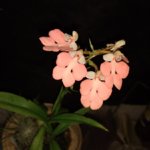

Epimedium 'Flowers of Sulphur', Alpine Water Fern (Blechnum penna-marina) and Corsican mint. About 30cm tall. I put this together as a live demonstration at a public-facing show in a botanical gardens this weekend. The pot and plants were all bought on site, and the plant went out on the show tables immediately on completion. Quite fun!


wsteinhoff
Shohin
Forsoothe!
Imperial Masterpiece
Forsoothe!
Imperial Masterpiece
Forsoothe!
Imperial Masterpiece
Forsoothe!
Imperial Masterpiece
Starfox
Masterpiece
Shima
Omono
They do need to be slightly damp, not soggy, not really wet, just damp. And I have yet to get it just right. So far this was second attempt to get it right. Maybe next time I will get it right. I do bloom it's more tropical cousins reasonably well.
The two Habenarias below are from wet-dry monsoon areas of Thailand. They will drop their leaves after blooming and then want to be bone dry until the rain returns in our spring.
The red is Habenaria rhodocheila and the pink is Habenaria erichmichaelii. The rhodocheila is in an Chang Ching-wen pot.
View attachment 232231
View attachment 232232
View attachment 232233
View attachment 232234
Probably Florida air is slightly damp enough.They do need to be slightly damp, not soggy, not really wet, just damp.
Brian Van Fleet
Pretty Fly for a Bonsai Guy
Great composition! Love the pot, stand, and plant. I am no good at accents, probably need to work on that.Epimedium 'Flowers of Sulphur', Alpine Water Fern (Blechnum penna-marina) and Corsican mint. About 30cm tall. I put this together as a live demonstration at a public-facing show in a botanical gardens this weekend. The pot and plants were all bought on site, and the plant went out on the show tables immediately on completion. Quite fun!
View attachment 233895
Brian Van Fleet
Pretty Fly for a Bonsai Guy
Similar threads
- Replies
- 2
- Views
- 737
- Replies
- 5
- Views
- 2K



